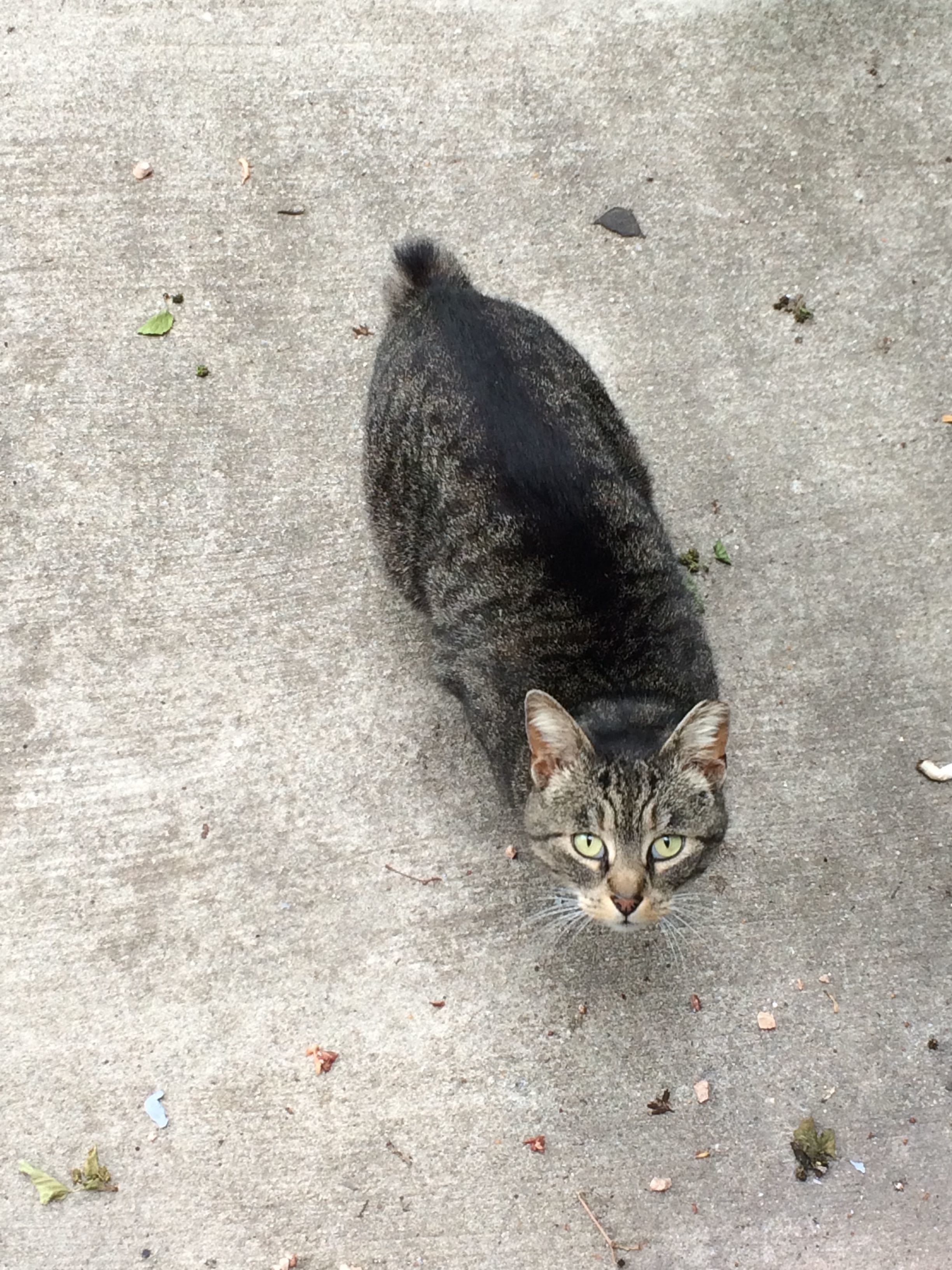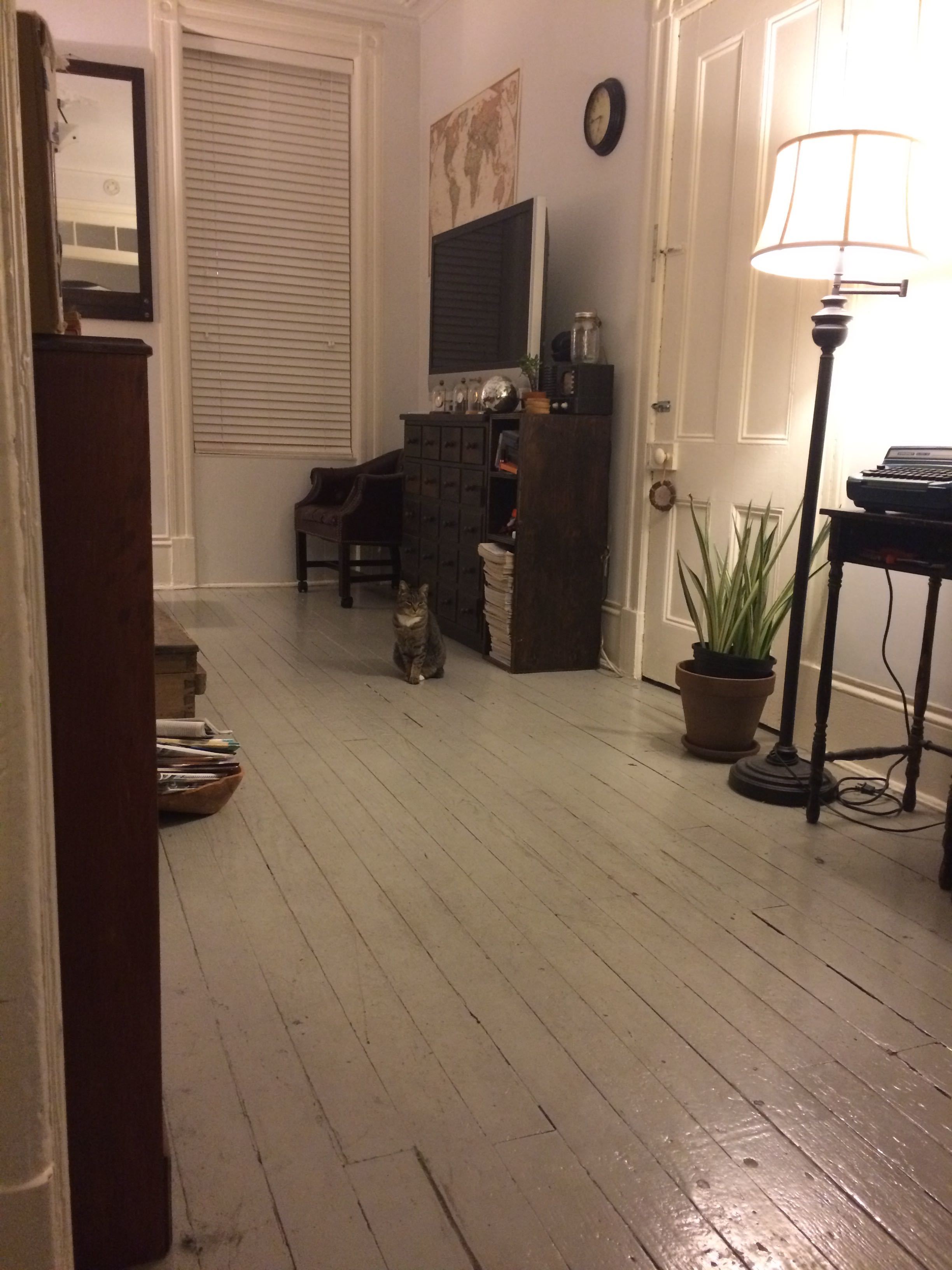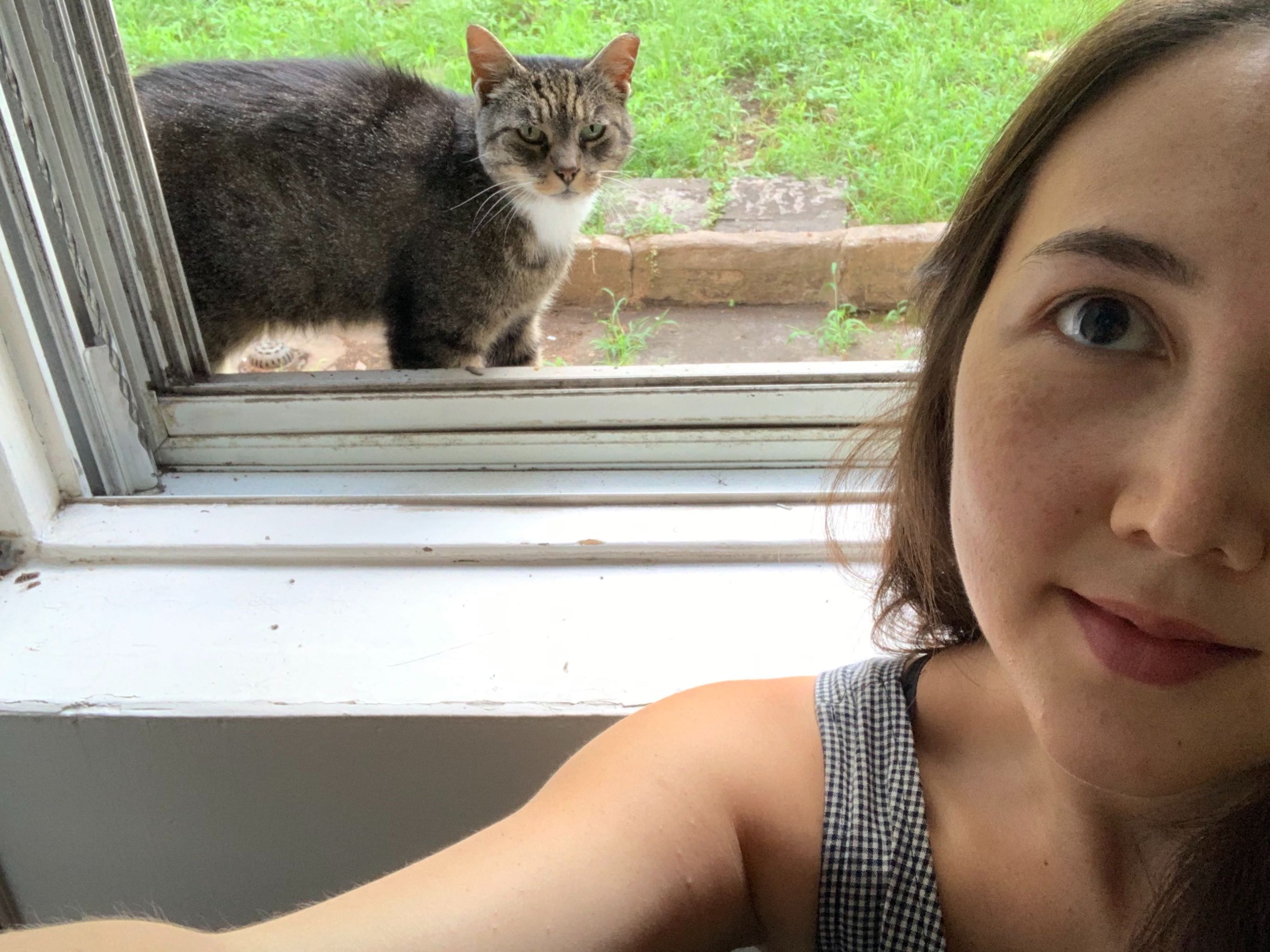Lessons on Anxiety From a Stray Cat
Credit to Author: Shayla Love| Date: Fri, 15 Nov 2019 13:12:59 +0000
During New York City’s harshest weather, snowstorms and heat waves, my kitchen window in Brooklyn is usually open. The screen too. This lets in bugs, dirt, ice, or humidity, depending on the season. I expose myself to these elements so that a stray cat can come in through the window and seek shelter—if he wants to.
I moved into my apartment in the fall of 2014. It’s a first-floor railroad in a brick rowhouse overlooking a garden that none of the tenants have access to. As a result, the yard is a wild place. Its only human trespassers are the occasional handyman or gardener.
The cat appeared shortly after I moved in. He was a small grey and white tabby, with a fuzzy nub on his behind where a tail should be. I named him Nubbin. After seeing him dart through the yard a few times, I bought a can of Friskies, put it on a plate on the windowsill, and was happily surprised when he came and ate it all up. Now, I feed Nubbin two or three times a day.
Nubbin is an anxious and neurotic creature. He won’t let me pet him. When I put out his food, he jumps away and returns only when I’ve moved out of sight. When I proudly gave him a salmon filet I had bought and cooked just for him (I'm vegan), he didn't take a single bite. Nor would he consider eating the seafood medley Fancy Feast I offered him. I’ve since learned he won’t eat anything but chicken-flavored food, or the original flavored Meow Mix dry food.

I’m an anxious and neurotic creature, too. I have issues around certain foods and textures, and eating in front of others. When I was a kid, I worried about germs and the cleanliness of my hands. I worried constantly that I was going to throw up or choke. I worried about whether my teachers hated me, and that a disease was slowly destroying all the cells in my body. As I got older, these anxieties persisted, and I eventually got a diagnosis of OCD, or obsessive-compulsive disorder.
A friend who lived in my apartment right before me told me he never saw any cat, not in the yard, and definitely not on the windowsill. I’ve decided Nubbin is a companion especially for me—a kind of spiritual familiar brought forth to teach me lessons, though ultimately, not the ones I expected.
When I met Nubbin in 2014, I was two years into talk therapy. As an adult, my contamination and illness phobias had remained, as did the fear of vomiting. I also developed a crippling amount of perfectionism; a desire to perform at an exceptional level—or not at all, nothing always being better than subpar.
Before therapy, I had resorted only to unhealthy means to quiet my frequently anxious mind. Heavy use of drugs and alcohol was one strategy, to smother anxious thoughts with inebriation. Avoidance was another. I simply did not do anything that made me anxious. To ward off perfectionism, I would skip, or completely ghost, classes—and nearly failed out of undergraduate college as a result. I avoided long car rides I thought would make me puke, or foods I thought would make me sick.
A more complex tack: completing a ritual of my own invention, like buying and throwing away groceries unopened or obsessively going to the doctor and getting medical tests and scans. There was one eight-month period during which I subjected myself to all sorts of painful tests, like an EMG, which sticks electrode needles into your muscles and shocks them. At the time, I was convinced I had Multiple Sclerosis. I even signed myself up for a spinal tap, until my partner was somehow able to convince me not to go through with it. These strategies were attempts at achieving my ultimate goal: a mind free from intrusive thoughts. If only I could know for sure that I didn't have MS, or that I wouldn't throw up, or that I wouldn't do a bad job on anything, then I wouldn't have anxious thoughts anymore, right?
With the help of therapy, by 2016, I was a lot better at coping. I had managed to go to graduate school, complete prestigious internships, and was launching my career while in a stable relationship. But despite—or maybe because of—my being so busy, OCD was creeping back into my life.
I was bogged down with rituals and intrusive thoughts again, and barely hanging on to my newfound functionality. So I enrolled in a clinical trial for Cognitive Behavioral Therapy (CBT) targeted at OCD. I excitedly thought that by the end of the trial, I wouldn't have obsessions anymore, and that I'd regain complete control over my thoughts. I was wrong.
The trial incorporated a concept new to me: Acceptance and Commitment Therapy, or ACT. ACT is not about changing your thoughts at all—it asks you to accept that anxious thoughts exist, and instead shift the way you react to them. It was developed in 1982 by Steven Hayes, now a clinical psychologist at the University of Nevada, Reno. Hayes said the idea behind ACT emerged out his own anxiety disorder, which he described as a mix of panic disorder and social anxiety, with some obsessive compulsive features.
“I did all the logical, reasonable, sensible, pathological things people do with anxiety," he told me. "I tried to run from it, tried to fight it, tried to hide from it." None of that helped. So he stopped fighting, and ACT was born.
“We spend a lot of time trying to control anxiety and depression,” said Jon Ambramowitz, a clinical psychologist at the University of North Carolina and an OCD expert. “From an ACT perspective, we're going to stop playing tug of war, we're going to put down the rope. Instead of trying to win the game, we're just going to say, 'Okay, this is what I'm feeling right now.' And learn how to be flexible and still do the things that we value in our life.”
The word "acceptance" can be misconstrued in ACT. It's not about accepting that you will never get better, that you should give up, that you should never challenge yourself again. As I would learn, it was much more challenging to do nothing in the face of anxiety than to do something.
The exposure therapy part of cognitive behavioral therapy for OCD—in which someone with a phobia, say of germs, intentionally faces their fears, like by eating food off the ground—is notoriously difficult. But it was the ACT that I couldn't grasp. Anxiety is your body's alarm system and tells you when you are in danger. As such, anxious thoughts demand action. They beg you to do whatever it takes to make them go away. ACT is somewhat like lighting yourself on fire and trying not to move.
It seemed terribly wrong, even evolutionarily backwards, to simply let anxious thoughts continue to exist and live my life anyway. Abramowitz said this is a common misconception about treatment. "People come looking for a fix for their anxiety, but what we want to fix is their relationship to their anxiety," he said.
I wanted certainty and control, not psychological flexibility. When I realized that the trial wouldn't wash my mind clean of anxious thoughts, I dropped out.
Around the same time, I was determined to gain Nubbin's affection. As he was eating, I'd hover just out of sight, psyching myself up to stick my hand out and pet him, even though I knew he would hate it. (I could never bring myself to do it.)
I tried putting his food on the inside of the windowsill to lure him in. He would bend down to take a mouthful of food, then hastily move outside to chew. This ploy to get him inside would leave behind a mess of extra food, attracting hordes of ants.
This is about the time I started buying extravagant wet food flavors and cooking filets of fish for him—all of which he turned his nose up at. On one of our many trips to the local bodega, the woman who rang us up asked how many cats we had. "None," my boyfriend replied dryly. Her eyes widened ever so slightly as she bagged our cans of Friskies.
During a cold snap in early 2017, the temperature dropped so low that Nubbin finally relented. I had fed him and left the screen open, as I always did, and walked away into the next room. I heard a gentle plop on the ground and excitedly peeked into the kitchen. Nubbin had crossed the threshold.
For the next few days, he continued to come in from the cold. When I opened the screen, he'd sprint past us and into the living room, where he’d spend an hour or so napping on the couch. I was elated and immediately started scheming how I could further manipulate the situation to make this the new normal.

One night, after we had closed the kitchen window and gone to sleep, I woke up to a loud bang in the kitchen. Unbeknownst to me, Nubbin had still been inside. He was desperately trying to get out by launching his body against the glass, while yowling the horrible screech of a cat in distress. He hit the windowpane so hard he knocked the curtains down.
I rushed to open the window, but trying to advance while a cat-sized bullet ricocheted around me proved difficult. I caught sight of Nubbin's face—ears flattened to his head and black pupils widened in panic—and felt a rush of guilt. How could I explain to Nubbin that if he just calmly waited, stopped trying so hard to escape, I could let him back out?
Seeing him crash into the glass over and over was a mirror I didn't want to look into. I myself was constantly bashing into my anxious thoughts, frantically trying to escape them through brute force. But like Nubbin, all I was doing was hurting myself. If I could just be still, let the thoughts exist, they might eventually let me free.
When I finally got the window open, he shot out into the snowy night.
For almost five years, I tried to change this stray cat. I strove to break his resolve, make him less scared, more domesticated, more normal. For that same time period, I was also trying to change my thoughts. To shove them out of my mind through ritual, numb them with substances, or take great pains to avoid them altogether.
But as it turned out, that didn’t help either of us. The lesson I needed, which I eventually arrived at, was about giving up the one thing I prize the most: control.
When I see Nubbin sleeping in some corner of the yard, I ache to know that he'll always be ok. It’s hard not knowing know where he is much of the time. One day, he could stop showing up, leaving me with a half-used stock of cat food and wondering whether he's alive. Controlling him feels like the only solution to avoiding heartbreak, just like ruling my mind with an iron fist seemed like the only way to make it through each day. But in the end, I can't make Nubbin come inside or rub his face against my hand any more than I can become a person who doesn't have OCD.
I've been in CBT again for about two years, and am working with ACT again. In exposure therapy, I do things like eat yogurt that's been sitting out (a trigger for my contamination anxieties), or imagine that people think I'm terrible at my job. When I do these things, the floodgates of anxiety open up. Instead of frantically swimming against the tide, splashing and exerting all my energy, I float. I try to accept that just because those thoughts are there doesn't mean I have to do anything about them. That I'm not a failure for thinking them in the first place. A thought in my head can tell me a situation is unmanageable or unsafe, that I am imperfect, that a food will cause me harm, and I can let the thought exist—while living my life anyway.
Having a mental illness can make you feel like a failure. Simple tasks are exhausting—keeping a job, socializing, eating, having relationships, running errands, walking down the street. I don't actually have to change that. ACT isn't a panacea, but it is a tool for managing my anxiety during those basic activities.
I won't go as far as to say that a cat single-handedly taught me how to let go of my need for certainty. But making peace with the fact that I couldn't control him, and with the fact that my efforts were actually hurting him, did give me a tangible, visceral example of how little use—and even how damaging—holding on to control can be.
When new friends hear about Nubbin, they have all sorts of ideas for how I could make him mine. I could force him inside until he eventually adjusts, or put a GPS collar on him to see where else he goes. I'll admit, it still tempts me.

But I don’t have to change Nubbin to have a relationship with him, to enjoy his presence. I don’t have to change my thoughts in order to be healthy, to enjoy my life. That’s a kind of freedom I never imagined myself having, as someone who previously thought I would be a broken person with anxious thoughts until the day I’d be a fixed person with no anxious thoughts. When the lesson was wrapped in a furry package, it was easier for me to receive.
I tend to get up early, when the sun is just starting to rise. Nubbin is usually waiting on the windowsill. We eat breakfast together in the silent morning light. When he's done eating his original-flavored Meow Mix, he sticks around—tucking his paws under his body and gently closing his eyes while I write or send emails. I've still never touched him, but I’m finally okay with that.
Sign up for our newsletter to get the best of VICE delivered to your inbox daily.
Follow Shayla Love on Twitter.
This article originally appeared on VICE US.